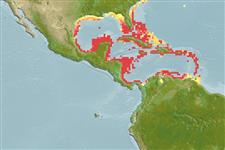Issue
The species in the genera Spratelloides Bleeker, 1851 and Jenkinsia Jordan & Evermann, 1896 should most probably be assigned to a separated family from Clupeidae and Dussumieriidae (Lavoué, pers. comm., July 2013). See a preliminary analysis in Lavoué et al. (2013: Ref. 93878).
Environment: milieu / climate zone / depth range / distribution range
Ecologia
marinhas associadas(os) a recifes; intervalo de profundidade 0 - 50 m. Subtropical; 34°N - 8°N, 100°W - 60°W (Ref. 188)
Western Central Atlantic: Bermuda, Florida (USA), Gulf of Mexico and Caribbean south to Tobago. Antilles (Ref. 26938).
Comprimento de primeira maturação / Tamanho / Peso / Idade
Maturity: Lm 2.8, range 2 - ? cm
Max length : 7.5 cm TL macho/indeterminado; (Ref. 9710)
Espinhos dorsais (total) : 0; Espinhos anais: 0; Vértebras: 40 - 43. Lower gill raker counts, show some correlation with geographical area, suggesting that the species may comprise three races or subspecies. W-shaped pelvic scute; pre-maxillae toothed, 1 supra-maxilla; isthmus slender, but with slight 'shoulders' anteriorly; vertebrae 40 to 43 (usually 42 - Venezuela); silver lateral band not becoming narrower or fading near gill opening (Ref. 188). Chest is slightly keeled. Small anal fin. Faintly greenish above (Ref. 37032).
A schooling species usually occurring inshore. Feeds on zooplankton. Preyed upon by many larger fishes and squids (Ref. 5521). Important as live bait for scombrids (Ref. 26340). In 1937, at Kingston, Jamaica it spawns during the winter months. Travels long distance (Ref. 37032).
Ciclo de vida ou comportamento de acasalamento
Maturities | Reprodução | Spawnings | Egg(s) | Fecundities | Larvas
Whitehead, P.J.P., 1985. FAO Species Catalogue. Vol. 7. Clupeoid fishes of the world (suborder Clupeoidei). An annotated and illustrated catalogue of the herrings, sardines, pilchards, sprats, shads, anchovies and wolf-herrings. FAO Fish. Synop. 125(7/1):1-303. Rome: FAO. (Ref. 188)
Status na Lista Vermelha da UICN (Ref. 130435)
Ameaça para os humanos
Harmless
Uso pelos humanos
Pescarias: pouco comercial; isca: usually
Ferramentas
Relatórios especiais
Baixar XML
Fontes da internet
Estimates based on models
Preferred temperature (Ref.
123201): 24.4 - 28, mean 26.8 °C (based on 200 cells).
Índice de diversidade filogenética (Ref.
82804): PD
50 = 0.5625 [Uniqueness, from 0.5 = low to 2.0 = high].
Bayesian length-weight: a=0.00692 (0.00358 - 0.01337), b=3.26 (3.09 - 3.43), in cm total length, based on LWR estimates for this species & (Sub)family-body (Ref.
93245).
Nível Trófico (Ref.
69278): 3.3 ±0.3 se; based on diet studies.
Generation time: 0.3 ( na - na) years. Estimated as median ln(3)/K based on 1
growth studies.
Resiliência (Ref.
120179): Elevada, tempo mínimo de duplicação da população menor que 15 meses (tm<1; K>0.3).
Fishing Vulnerability (Ref.
59153): Low vulnerability (10 of 100).
Nutrients (Ref.
124155): Calcium = 177 [73, 638] mg/100g; Iron = 2.61 [0.98, 5.72] mg/100g; Protein = 19.7 [17.9, 21.3] %; Omega3 = 0.356 [0.102, 1.308] g/100g; Selenium = 34 [9, 124] μg/100g; VitaminA = 26.6 [4.9, 168.4] μg/100g; Zinc = 2.25 [1.12, 4.22] mg/100g (wet weight);
